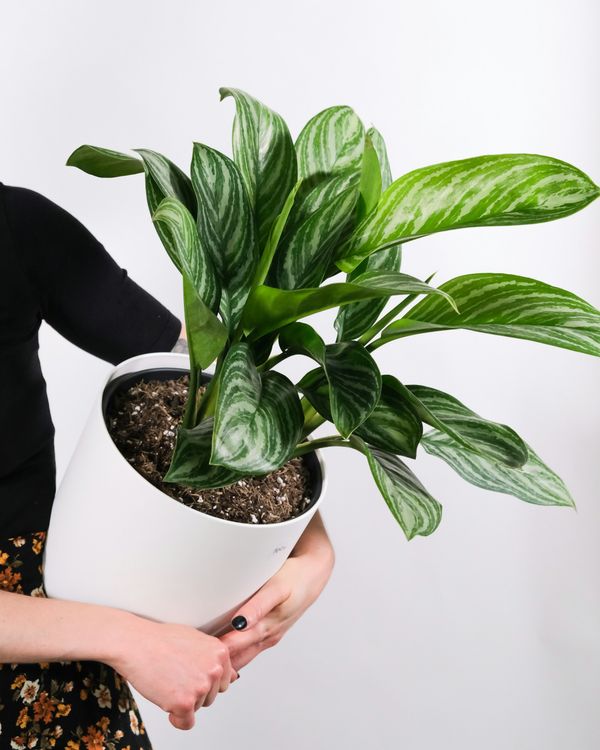Chinese Evergreen Care Guide
How to grow and care for Chinese Evergreen (Aglaonema spp.)
Aglaonema spp., commonly known as Chinese Evergreen, is a popular choice for indoor plant enthusiasts due to its striking foliage and easygoing nature. Known for their ability to thrive in low light and with minimal care, these plants are a perfect addition to homes and offices alike. Their vibrant leaves come in various shades of green, red, pink, and silver, adding a touch of color to any indoor space.

Disclosure: This content includes affiliate links, which means we may earn a commission if you click on a link and make a purchase. As an Amazon Associate, we earn from qualifying purchases. This comes at no extra cost to you and helps offset the cost of running Leafwise. Please read our disclaimer for more info.
Table of Contents
Care
Light
Aglaonema, also known as Chinese Evergreen, thrives in low to medium light but performs best in bright, indirect light. Avoid direct sunlight, as it can scorch its leaves. Variegated varieties with lighter-colored leaves require brighter light to maintain their vibrant patterns. It is an ideal plant for areas with filtered light or artificial indoor lighting.
Watering
Water thoroughly when the top inch of soil feels dry. Allow excess water to drain out to avoid root rot. Aglaonema prefers evenly moist soil but should never sit in waterlogged conditions. In lower light conditions, allow the soil to dry out more thoroughly before watering again. Reduce watering during the winter months.
Humidity & Temperature
Maintain temperatures between 65°F and 75°F (18°C and 24°C). Aglaonema appreciates moderate to high humidity, and increasing humidity during dry periods can prevent leaf browning. Consider misting the plant regularly, placing it on a pebble tray with water, or using a humidifier to maintain moisture levels.
Soil
Use a well-draining potting mix rich in organic matter. A combination of potting soil, perlite, and peat moss works well, ensuring the soil retains moisture without becoming soggy.
Fertilization
Feed your Aglaonema monthly during the growing season (spring and summer) with a balanced, water-soluble fertilizer diluted to half strength. Reduce feeding in fall and winter when growth slows.
Maintenance
Pruning
Prune any yellow, brown, or damaged leaves to maintain the plant’s aesthetic and redirect its energy to healthy growth. Use clean, sharp scissors to avoid spreading diseases.
Cleaning
Wipe the leaves with a damp cloth to remove dust and improve the plant’s ability to photosynthesize. Regular cleaning also helps prevent pest infestations. Avoid using leaf shine products, as they can damage the foliage.
Repotting
Repot every 1-2 years or when the plant becomes root-bound. Choose a pot 1-2 inches larger and refresh the soil to maintain healthy growth.
Propagation
Aglaonema can be propagated through division or stem cuttings, both effective methods for creating healthy new plants:
Division – When repotting, gently separate clusters of shoots with roots intact and plant them in their own pots.
Stem Cuttings – Cut a healthy stem just below a node using a sterilized knife or pruning shears. The cutting should ideally be 4-6 inches long and include at least one healthy leaf. You can propagate using either of the following methods:
- Water Propagation – Place the cutting in a jar of clean, room-temperature water, ensuring that the node is submerged. Change the water weekly to prevent bacterial growth. Once roots are 2-3 inches long (typically in 4-6 weeks), transfer the cutting to a pot with moist, well-draining soil.
- Soil Propagation – Dip the cut end in rooting hormone to promote faster rooting (optional). Plant the cutting directly into a pot filled with moist, well-draining soil. Keep the soil consistently moist (but not soggy) and cover the pot with a clear plastic bag to create a mini greenhouse effect, retaining humidity.
Aftercare: Regardless of the method, place the new plants in a warm, humid environment with bright, indirect light to encourage healthy root development and growth.
Common Issues
Pests
Aglaonema can occasionally attract common houseplant pests such as spider mites, mealybugs, and aphids. These pests often appear due to dry indoor conditions, poor airflow, or dusty leaves.
- Prevention: Regularly inspect the plant, clean the leaves with a damp cloth, and maintain good humidity.
- Solution: Wipe the leaves with a mixture of water and mild dish soap, or apply neem oil or insecticidal soap weekly until the infestation is cleared.
Root Rot
Root rot is a common and serious issue caused by overwatering or poorly draining soil.
- Prevention: Ensure proper drainage by using a well-draining potting mix and pots with drainage holes. Let the soil partially dry out between waterings.
- Solution: If root rot occurs, remove the plant from its pot, trim off any mushy or blackened roots, and repot in fresh soil. Adjust your watering practices to prevent recurrence.
Yellowing Leaves
Yellow leaves can result from overwatering, insufficient light, or low humidity.
- Solution: Check the soil moisture and allow it to dry partially if overwatered. If the plant is in a low-light area, move it to a brighter location with indirect light. Increase humidity using a humidifier or pebble tray, and apply a balanced fertilizer if nutrient deficiency is suspected.
Brown Leaf Tips or Edges
Cause: Low humidity, inconsistent watering, or exposure to tap water containing salts and minerals.
- Solution: Increase humidity by misting regularly or using a humidifier. Maintain consistent watering habits, and use distilled or filtered water to prevent mineral buildup on the leaves.
By following this care guide, your Aglaonema will remain a lush and vibrant presence in your indoor space, delighting you with its low-maintenance, elegant charm.
